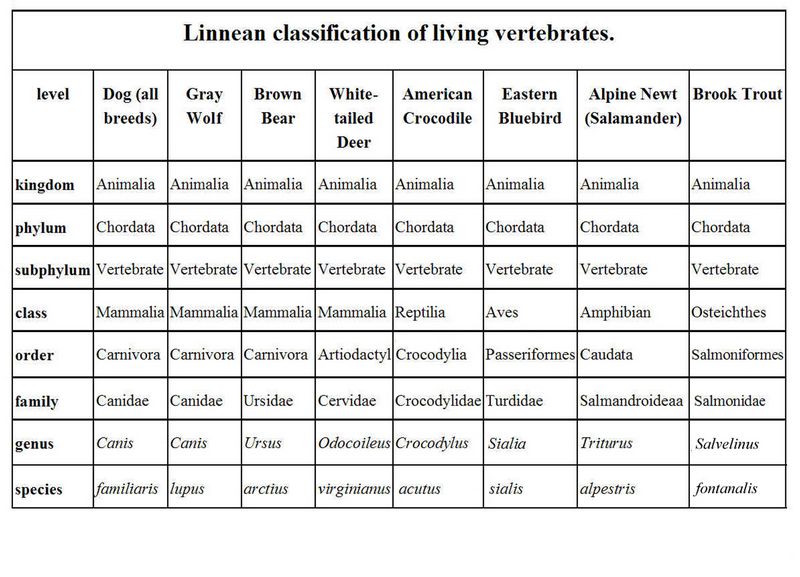Athena Review Image Archive ™
Classification of Vertebrates in Linnean system

The Linnean classification of living beings, created by Carl Linnaeus (1707-1778), is well known in its detailed level of genus and species, such as Canis familiaris (always italicized) for dogs. This binomial classification is part of a larger hierarchy of ranks, such as shown in this table. Species can also be also subdivided into varieties, such as used for dog breeds.
As seen in the table, the taxonomy for the gray wolf (Canis lupus), considered the direct ancestor of domestic dogs, is nearly identical except that the wolf has the species name lupus (Latin for "wolf"). The dog (Canis familiaris) has changed enough under domestication to be considered a distinct species, and usually not capable of interbreeding with wolves.
The full Linnean taxonomy of a dog includes a number of more generalized ranks, including Kingdom (animals), phylum (chordates), subphylum (vertebrates), class (mammals), order (carnivores), and family (canidae). For other carnivores, such as the brown bear Ursus arctius, all levels above that of family (Ursidae, Latin for “bears”) remain the same as for dogs and wolves. Grazing animals such as the white-tailed deer (Odocoileus virginianus, named for Virginia deer) belong to a different order, Artiodactylus (Greek for “even-toed”), and a different family (Cervidae, Latin for “deer”).
The common ancestors of deer, wolves, bears, and other mammals represent small, primitive mammals dating from the Late Cretaceous through Eocene periods (about 75-55 mya), before their descendants specialized into the different orders of Carnivores and Artiodactyls. The common ancestors of reptiles and mammals, called synapsids, had first evolved in the Carboniferous period about 330 million years ago. Reptiles, amphibians, and fish diverged still further backward in time. The common ancestors of all vertebrates are chordates or primitive fish that first appeared in the Cambrian and Ordovician periods, up to 500-540 million years ago.
The same ranks or categories used for extant species are also used for fossils. The Linnean system, as in zoology or botany, is a static, hierarchical system not necessarily representative of ancestral or phylogenetic relations of animals. Still, as a commonly understood system, it is usefully built into discussions of fossil evidence based on cladistic phylogenies.
References:
.Copyright © 1996-2020 Rust Family Foundation (All Rights Reserved).